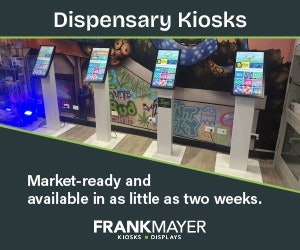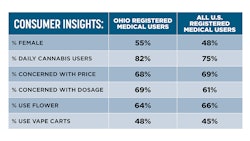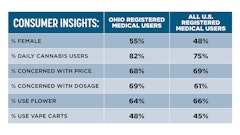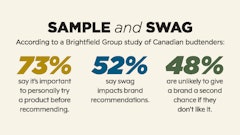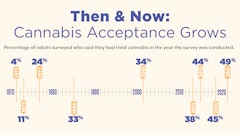
More American seniors are clamoring for cannabis than ever before, a new study found, and several cannabis executives and specialists aren’t surprised: Older cannabis users are turning to a medicine to treat a range of chronic conditions while also spreading word-of-mouth advice to friends and family on how cannabis helps them.
Yet as much as some marketing campaigns have been geared to seniors, cannabis companies still may be missing the mark in capturing the attention of this increasingly significant demographic.
Cannabis use among older adults has reached a new high in the U.S., with 7% of those 65 and older reporting adding it to their lives in the past month, according to a June 2025 study led by researchers with the Center for Drug Use and HIV/HCV Research (CDUHR) at the NYU School of Global Public Health.
That figure, determined in 2023, is up from 4.8% in 2021 and 5.2% in 2022, a 46% increase in only two years.
Furthermore, 21% of U.S. adults age 50 and older said they used a form of cannabis with THC at least once in the past year, according to a 2024 national survey on health and aging conducted by pollsters at the University of Michigan.
Also, a large number of older cannabis users are open to discussing the medicine with their doctor. That same survey found that among older adults who used cannabis at least once a month, 56% have discussed cannabis with their health care providers.
 Benjamin HanCourtesy of Benjamin Han
Benjamin HanCourtesy of Benjamin Han
In the past several years, dozens of cannabis companies have been edging toward appealing to this rising demographic: brand ambassadors over 60 include Melissa Etheridge, Whoopi Goldberg and Tommy Chong. Also, the Cannabis Media Council launched the “I’m High Right Now” marketing campaign for users over 55, available on Instagram and Facebook. Bristol Extracts in New York even went so far as to name one of its product lines as Senior Moments.
 Cameron ClarkeCourtesy of Cameron Clarke
Cameron ClarkeCourtesy of Cameron Clarke
Clarke says that these older cannabis users are gradually ignoring the stigma levied on them due to the misinformation stemming from the heyday of the drug war, when cannabis was often viewed as a gateway drug or exceptionally unhealthy.
A leading expert on cannabis’s medical benefits agrees with Clarke. Peter Grinspoon, author of Seeing Through the Smoke: A Cannabis Specialist Untangles the Truth About Marijuana and a primary care physician and cannabis specialist at Massachusetts General Hospital, says, “The cannabis stigma is diminishing among these Americans because they are hearing from friends and their kids how effective cannabis may be, and that’s counterbalancing the many years of the drug war nonsense they’ve heard.”
 Dr. Peter GrinspoonCourtesy of Peter Grinspoon
Dr. Peter GrinspoonCourtesy of Peter Grinspoon
What cannabis companies stress, though, is educating older Americans on a product they may have never tried until recently.
Krissy Bernazani, national clinical director at multistate operator Verano, has led lunch-and-learn events and educational sessions at cancer and Parkinson’s disease patient groups on the East Coast to inform seniors on the pros and cons of cannabis and identify the ideal product for them.
“One thing we often educate them about is to use a low-dose edible, a format that is discrete and makes the experience feel more like a natural part of an existing wellness plan,” Bernazani says.
 Krissy BernazaniCourtesy of Krissy Bernazani
Krissy BernazaniCourtesy of Krissy Bernazani
Also, among 4,500 older veterans looking for care at Veterans Affairs (VA) health facilities, researchers found that more than 10% had reported cannabis use within the past 30 days. Of those veterans, 36 percent fit the criteria for mild, moderate or severe cannabis use disorder, as established in the Diagnostic and Statistical Manual of Mental Disorders.
Editor’s note: The study was supported by grants from the National Institutes of Health and the Tobacco Related Disease Research Program.
Clarke says his cannabis advisers will be clear to seniors about the unpredictable nature of edibles, as one dose may last longer for someone than the other, and they stress to customers how reliable Sunderstorm products may be for ingestion. Clarke points to how the company won a 2018 award for the “Most Accurately Formulated Edible.”
Sunderstorm launched several marketing campaigns over the past five years to attract seniors to its products, adding models over 65 to the company’s brochure campaigns, for example. Sunderstorm also promoted in dispensaries a product line focused on helping older customers with sleep conditions.
 Courtesy of Sunderstorm
Courtesy of Sunderstorm
Clarke and Bernazani have recognized how word-of-mouth messaging has been critical to educate seniors about what cannabis does for a slew of ailments, which fills a widening gap in how seniors learn more about certain products and side effects.
What Clarke finds concerning, albeit not very surprising, is how dispensaries solely seek to cater to the younger demographics. “It makes sense, though, as older populations aren’t shopping as regularly, sometimes going into stores once a quarter,” he says, which results in a slimmer variety of products for these customers.
He says, too, shelf space is expensive to procure, encouraging cannabis brands to push high-THC products appealing to more frequent shoppers, such as millennials.
But when older Americans are neglected by cannabis companies, Clarke says, “They have done the industry the disservice, and I think they can work harder to reverse this trend.”
Another challenge, Bernazani says, is ensuring a cannabis company’s educational campaign aimed at seniors reaches those who may have emigrated from a country intolerant to any kind of cannabis product.
“What I’ve encountered speaking at senior groups is that there may be someone who came from a place where cannabis is forbidden,” she says, “but what resonates with them is the safety issue. We educate them on how to look at this plant holistically, and how the impact of using cannabis is gentler and more subtle than the prescription medicines they may have been using for years.”



